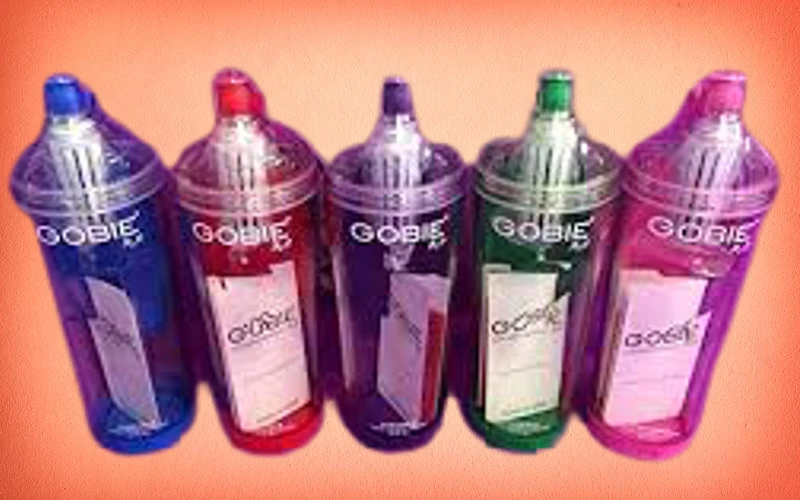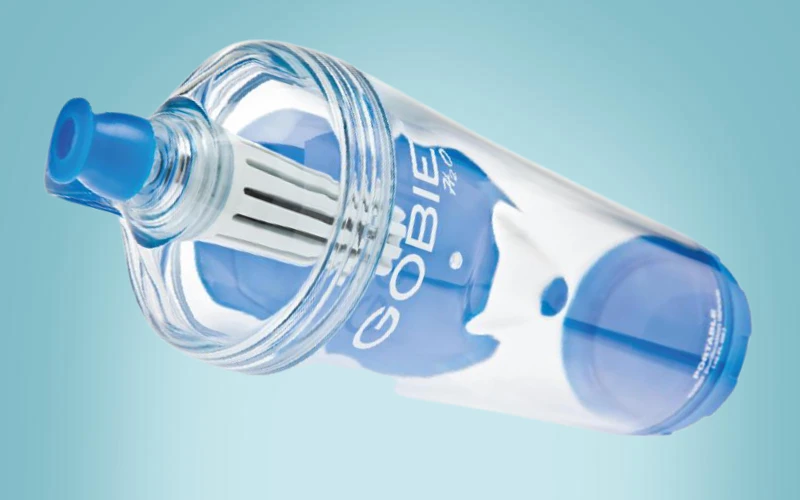Table of Contents
Before Shark Tank, Gobie H20
Rusty Allen is an industrial designer who created the “most sophisticated filtered water bottle,” according to him. His bottle, dubbed, featured a one-of-a-kind design that combined hard and soft shell technologies. The drinker can simply grip the bottle and pull it up through the filter thanks to the soft shell part.
After becoming upset with the amount of money he spent on single-use water bottles, he came up with the concept. He said he discovered he was spending more money on water bottles than he did on petrol to fuel his vehicle at one point.
In April 2013, he made his fourth-season debut on Shark Tank in the 21st episode.
On Shark Tank, Gobie H20
https://youtu.be/rfKpIXzbjkM
Episode 21 of Season 4 of Shark Tank
Rusty’s shark pitch featured a 10% stake in his business in exchange for a $300,000 investment. He started by highlighting the bottle’s distinctive shape – soft shell and hard shell – before telling the sharks that his filter was capable of filtering out 99.9% of all pollutants in normal drinking water, which is what the customer would use to fill the bottle.
He proved his point by filling a bottle with both tap water and potting soil, shaking it vigorously, and then pouring it into a glass. Rusty sipped the water in the glass, which was clear.
Kevin was perplexed as to who the target market was. Was Gobie H20 intended to compete in the already congested water bottle industry, or was he hoping to deliver it to parts of the globe where safe drinking water is scarce? Rusty said that his aim was to compete with the US market for single-use water bottles.
Kevin still didn’t understand how it was a successful approach, given that most Americans had drinkable tap water. Mark chimed on, saying that most people believe tap water is OK, but that there are bottles on the market with filters that are enough.
Robert was the next to speak out. He informed Rusty that his kids have been using an internal filter water bottle for many years.
Lori believed that the only significant distinction between the Gobie bottle and others on the market is Rusty’s product’s unique design – hardshell with softshell. She’s seen a lot of different water bottles for sale that either come with a filter or can be added afterwards.
The mix of soft and hard materials, according to Rusty, performed better at water filtration than either soft squeeze bottles or hard bottles could accomplish on their own. He said that squeeze bottles were often manufactured cheaply and would not survive the life of the filter. The water was difficult to pull in through the filter because of the hard bottles. Gobie H20, on the other hand, would utilise the soft side to build up pressure, allowing the water to flow more freely through the filter.
Daymond was looking for figures. What was the selling price, and how much did it cost to make? It retailed for $30, according to Rusty, and it cost $10 to make. The bottle included one filter that would last three months or 100 gallons, after which the customer would need to purchase a new filter every three months. Mark inquired as to whether he had created the filter himself or had licenced the technology. The technology to build the filter, according to Rusty, was accessible on the open market. It was little more than a carbon brick.
Daymond and Robert were both interested in learning more about the statistics. How much money has he made from sales? Over the period of 17 months, Rusty informed them he had earned $285,000 in sales. He had contacted stores such as Bed Bath & Beyond, Target, and JC Penney, but all of his sales had been made online. They loved the bottle, he said, but they wouldn’t accept it until he had additional colours available.
Lori wasn’t convinced by the tale. Despite the paucity of colour options, she assumed that if Rusty had a really innovative bottle, merchants would have snapped it up. They didn’t want it, she thought since they already had comparable rivals who were presumably cheaper. She dropped out because she didn’t believe he could compete in this crowded market.
Kevin asked a straightforward question: Why was the product worth $3 million now, and what would it be worth tomorrow? Everyone moaned as Rusty attempted to justify the company’s value by claiming that everyone in the world drinks water, and Kevin stated it wasn’t the answer he was looking for. Kevin pulled out after that.
Mark had a few words to say. He felt it was a very nice-looking bottle and that he should be marketing it for the design rather than the water filtering capabilities, particularly because his water filter couldn’t block out more pollutants than any other filter on the market. Rusty, on the other hand, persisted in pitching the notion that his design might filter better than other bottles on the market. Mark became irritated and walked away.
Robert was the one who had the worst critique to give. He felt it was a bad presentation and that Rusty didn’t seem to understand what he was doing. Rusty, he thought, would be devastated. After that, he vanished.
Daymond was the only one who confessed to thinking the bottle was “sexy.” However, he was concerned about what the other sharks were saying. He inquired about Rusty’s plans with the $300,000. Rusty said that he required the money for inventory and operational expenses. Daymond then inquired about his debt, to which Rusty responded that he had none. Then Daymond made an offer: $300,000 for 40% of the business, which was much more than Rusty’s 10% offer during his presentation. Daymond also attached a condition to the deal: it had to be accepted by a large box retailer.
Daymond’s offer was challenged by Rusty, who asked if he would take 20%. Daymond said that he offered what the goods were worth to him. Rusty then requested if he may contact his business partner for advice. The sharks agreed, and after a short discussion, Rusty returned and requested Daymond to bring in Mark and Lori, two of the other sharks who had previously dropped out. Daymond, on the other hand, was not interested in becoming a part of it. He didn’t budge on his initial offer. Rusty took a moment to catch his breath before sprinting up to Daymond to shake his hand and accept the offer.
After Shark Tank, Gobie H20
The Gobie H20 website is still up and running, but there’s no indication of the water bottles being for sale. A blog article on how to sell effectively on Amazon may be found under “What’s New” on the site’s menu. It was published on 3/8/20. There’s also an article about what to look for when buying a water bottle, as well as a storey about Omaha’s drinking water. It’s unclear whether this URL was taken up by someone else in the water industry.
On Amazon, reviews were varied, with some praising the design and others claiming it was a mould trapper, that it broke soon after purchase, or that it began to leak.
Rusty’s LinkedIn profile contains information about Gobie H20 and says that it is still in operation (despite the fact that no store seems to offer it). Rusty is currently the creator of Happi Canine, which he describes as “the first daily fish oil-enriched CBD product especially intended for canines.”
The material in this article is given only for educational purposes; Royal Pitch is not connected with Sand Cloud, SharkTank, or any of its subsidiaries.
Visit the rest of the site for more articles.




0